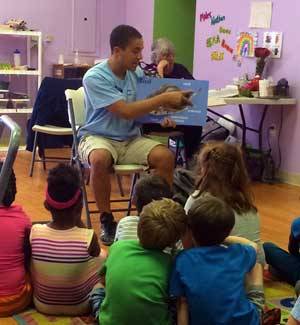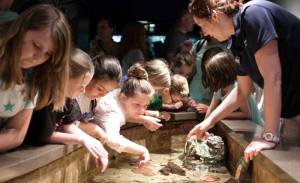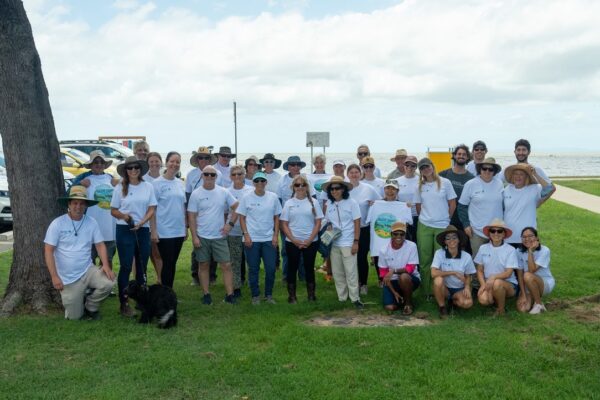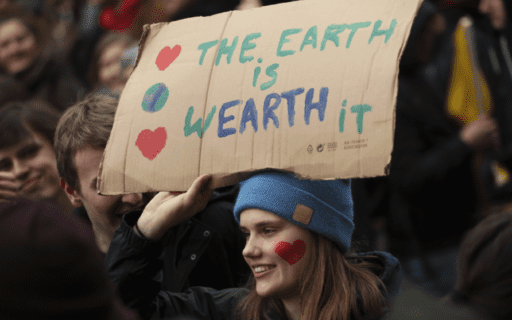This guest post by Heather Deschenes of New England Aquarium, the final in a 3-part series on the aquarium's Innovative Solutions Grants+ project, is a look at what the aquarium learned from their efforts. Thank you to Heather and everyone who helped at the aquarium for your hard work!
The Ocean Project’s Innovative Solutions grant enabled us to try a different approach to training our teen volunteers to engage various audiences about the steps those audiences might take reduce their fossil fuel use. Our hypothesis was that if the teens were able to convey their knowledge about climate change, then audiences would be more willing to act. Here's a summary of what we did, including the successes we had, as well as the lessons we learned.
Beginning the project
Our original vision for the ClimaTeens program was to develop an educational program that aimed to empower teens to stimulate an increase in community dialogue, planning, and action to address the issues of climate change. We aimed to develop the youth participants’ understanding of the science behind and impacts associated with global climate change, and a stronger sense of confidence in sharing this knowledge with peers, adults, and community leaders. Our goal was to create two academic year cohorts of students who would take part in monthly meetings where they would develop their content knowledge on the subject area, have opportunities to practice developing presentations and making connections with other youth audiences in the in the City of Boston and Aquarium visitors.
To form the first cohort of ClimaTeens, we recruited those who were already participating in other NEAq youth programs. We assembled a group of 12 who had varying levels of knowledge of climate change science and impacts. We experimented with the idea that, once all were up to speed, the teens could and would engage deeply with a topic as large and potentially scary as climate change. We found that the answer, overwhelmingly, was that they could and they would, even going so far as to talk with EPA Administrator Gina McCarthy, Energy Secretary Ernest Moniz, as well as Massachusetts Senator Ed Markey, and Boston Mayor Marty Walsh!
We set a goal of having the teens develop additional presentations, blog posts and videos that would all encourage a wide audience to join a citywide effort to reduce carbon emissions called Greenovate Boston. We anticipated being able to measure impacts of ClimaTEENS efforts because the Greenovate website was to be enabled with a number of built in evaluative properties. We were really excited about the opportunities presented by the partnership with Greenovate, and the web tools in particular, but as the project progressed, it became apparent that our timelines were not aligned. While Greenovate was making significant progress in developing the City’s Climate Action Plan (CAP), their website plans were much slower to take off.
A change of plans
By the fall of 2014, we knew we needed to change course, and we decided to put greater emphasis on having the teens presenting directly to aquarium visitors rather than the broader community. We also launched the second academic year cohort of ClimaTeens (retaining five alumni from the first cohort). So in addition to starting the process of training the new cohort, which had grown from 12 – 20 youth, we also started gathering data to support our evaluation strategy through a monthly program called Blue Discovery Family Days (BDFD.) Each BDFD has a theme (such as Lobsters, Octopus, or Sustainable Seafood) and an array of hands-on activities are set up either inside or outside the aquarium, depending on weather. Teens run most of the stations, with support from adult educators. For a series of fall and winter BDFD events this academic year, the ClimaTeens had a table in the same area as the other activities, but with a climate change-specific activity. The teens used interactives NEAq developed as part of a NOAA-funded climate education grant a few years ago. These activities feature either basic climate science, such as carbon sinks and sources, or human impacts, such as an ‘eco-footprint’ quiz. The teens were encouraged to convey the science and also engage visitors in solutions-oriented conversations, touching on three specific actions the visitors might take (wash laundry in cold water, request a home energy audit, and/or connect with a community-based effort such as Greenovate).
After visitors had the opportunity to interact with the teens, an adult educator would ask a random sample of visitors leaving that area if they were willing to complete a short survey on an iPad. The surveys asked some attitudinal questions and also asked visitors to indicate their willingness to take the three possible actions the teens were mentioning. Since NEAq surveys visitors on many subjects, we were already aware that our visitorship is generally interested in and concerned about climate change, but we didn't know if the interactions with the teens would increase a visitor's willingness to take action.
Looking at the data
While the data we gathered was not statistically significant, it did suggest that interacting with the teens could indeed help expand our visitor's willingness to act.
When we compared the responses of those who did interact with the teens ("yes group") and those who did not ("no group"), we couldn't help but notice that those in the "yes group" seemed to be coming into the conversations with a higher level of interest in the issue. A strikingly high 26% of those in the "yes group" reported that they already were involved with a community-based effort such as Greenovate, whereas that number dropped to 8% for those in the "no group."
At the same time, we still saw some evidence that interacting with the teens was having an impact. When we compared yes and no group responses on the other two actions - washing clothes in cold water and requesting a home energy audit - approximately equal percentages from each group reported that they were already taking those actions prior to their visit. However, among those who were not already taking those steps prior to their visit, those who interacted with one of the teens did report a notably higher willingness to take these actions in the future.
What we still do not know, however, is the extent to which that difference in response was due to the provision of new information about the solution steps, new information about the underlying problem, and/or the personal nature of the interactions. Our "gut sense" would be that the impact we saw was largely attributable to an already interested audience being provided with new information about solution steps they could take by a group of enthusiastic interpreters. But as they say in academia, "more study is needed!"
Over the course of our ClimaTeens adventure, we have learned that our teens are capable of understanding large and complex topics with a mixture of wisdom, enthusiasm, and energy that inspires the adults around them. We also have learned that getting a group of young people around a table to share pizza and ideas can be silly, deep, chaotic, and ultimately incredibly rewarding. One note of caution for our colleagues in the Aquarium and Zoo community looking into this kind of program, however - the same teens that are deeply engaged leaders in your institution are most likely deeply engaged students, athletes, performers, and leaders in their school and home communities, and they may become overcommitted.
Other lessons learned
- Coordinating with a community wide effort on a scale like Greenovate can be, despite the best of intentions on both sides, really tough, especially with the limited availability of the teens themselves and just the basic operational differences between organizations
- We learned the teens didn’t need in-depth training on climate science but rather needed the time to build their confidence in speaking about climate basics. The teens often expressed that building their own social identity was more important that learning the scientific information.
- Having the teens already invested in our organizational mission was really helpful. For example, our second cohort of teens (formed in fall 2014) has had considerable attrition because many of participants were new to the Aquarium and the expectations on behalf of the program and the teens themselves, were very different.
When asked what lies ahead for ClimaTeens, there are some unknowns (program funding) but there are also some certainties. The youth who continue to participate in the program are really emerging as model ocean stewards, something that is core to our institutional mission and goals.
These youth all have some very positive traits in common; they see involvement with ocean-helping activities as crucial part of life, many are actively pursuing schooling that will help them to work in an ocean/environment related career, they are well educated on ocean issues and can speak articulately about the issues, frequently talking with others and sharing their passion to help raise awareness.
We are very excited to see what these teens will do next and really appreciate that this grant helped us to empower a group of young people who understand their connections to the ocean and participate as a community of informed citizens who are inspired to change the world.




